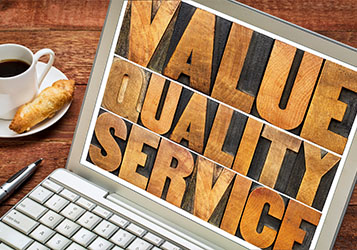The same story has been heard over the past 5-10 years. Print is dead. Either go digital or die out with the dinosaurs. When you look underneath this headline statement, and at the reality of the current marketing landscape, you will soon discover that is not exactly the case. Of course, it would be churlish to suggest that the rise of digital marketing hasn’t increased significantly during that period but equally, the most successful marketing campaigns find a way to combine both physical and digital material maintaining that there is still real value of print.
The print industry has been declared dead in the water a number of times over the course of its existence, but by listening and adapting to customer’s needs, it still remains an important part of the marketing mix. Just as vinyl records were declared redundant, there has been a surge of interest once again in the format (3.2m sold last year, which is a 25-year high), proving that a tangible product helps to develop a sense of trust and a personal connection that is so important to the process of buying and selling.
The question is, if you can deliver a trackable message via email shots to more people, for less money and with a faster turnaround time than traditional print methods, why continue to use a print channel?
The answer is easy: while the technology may have changed, the people using it haven’t.
You could ask yourself, why continue to use cash when you can pay for everything on card? Or, why buy a blu-ray/dvd when you can rent and stream it online? Without delving too far into the human psyche, it’s easy to understand that we are tactile creatures, who need to interact with the products and services we are interested in. From the banking system, the buying and selling of products and right down to our relationships with friends and family, almost everything we do is based on trust.
A Constant Reminder
Emails are fantastic because they can be delivered within seconds containing all the offers and links you need to sell your product or service. Except, with a couple of clicks, the senders email address can be blocked forever, or filtered into an ever growing pile of similar emails in a separate folder. Typically you’ll only ever go back to look at this folder if a) you have the time or b) you have a specific need to do so.
Print marketing serves as a constant reminder of what it is you are trying to tell to the recipient. Unless they are high-flying execs, the only way people will filter out their mail is by hand, which means at the very least they will see the printed material. If you receive a Chinese takeaway leaflet through the door, the chances are you will keep it on top of the fridge or nearby for future use. Having a tangible product in your hand creates an instant sense of trust and credibility that digital media can struggle to achieve.
 Think outside the box
Think outside the box
Print is often thought about in terms of the fundamental products it can supply; leaflets, brochures, business cards and the like. All of which are the ‘bread and butter’ of many marketing campaigns. But the use of promotional marketing has soared in the past decade and, similar to what was discussed above about interactivity, can forge a deeper relationship with the consumer.
Something as simple as a pen, mug and even clothing keeps brand awareness constantly alive with the people who interact with the items and even regular observers. Placing your brand in the eye line of your customer base doesn’t mean they will instantly head out to buy your product or service. But it serves as a daily reminder of the company, your services and above all, creates a familiarity with brand.
Longevity
Print also lasts forever. Web content is created every single day and there is fierce competition for advertising space. The message you have available today, can quickly be buried deep within the web, never to be seen again. Of course, this is why new content is created every day, but while this may prove more cost effective in terms of initial financial outlay, the price internally is far higher, given the amount of time and resource that is dedicated to constantly refreshing the message to ensure if stays relevant.
With digital ad-blocking on the rise, this is a growing issue facing many companies who have no control over how their customers interact with the brand. Just like the email filter, once adverts are blocked on a website, they are highly unlikely ever to be seen again by that customer.
 Take Your Time
Take Your Time
While we have all embraced the positive impact of the digital world to varying degrees, voices of dissent have begun to grow in recent years. This isn’t to suggest that it will eventually lead to the reversal of our digital evolution, and nor should that be the case. But there are lessons to be learned and some divides that exist between physical and digital marketing that are particularly difficult to bridge.
One of which is probably the precious commodity of all. Time. The pace of modern life seems to be getting faster with every year that passes and things like the resurgence of vinyl records and the reappearance of old Nokia mobiles indicates that people are looking to take a breather where possible. Traditional print marketing methods allow people to take the time to engage with detail, as there are less distractions involved to push them away, with no pop-up ads or flashing sidebars to divert their attention.
For example, Coca-Cola are old masters at marketing, which is why they have become the conglomerate they now are. Their simple idea of printing people’s names onto the labels of their bottles lead to a significant increase in sales, because it developed a personalised relationship and in turn, trust (there’s that word again), with the consumer. In an age of many distractions, attention spans have become shorter than ever, so it is important you find a way to engage in a meaningful way.
While print cannot dominate the marketing industry as it once did, billions of pounds are still spent every year and it remains a fundamental part of any successful marketing campaign. We are not likely to disappear into a completely digitised world any time soon, so if you can make the most out of the benefits print marketing can offer, you are far more likely to see a profitable return.
We are confident that we can help you get the most out of your print and digital spend. Fill in the details below and we will explain how we can maximise the benefit from your spend.

